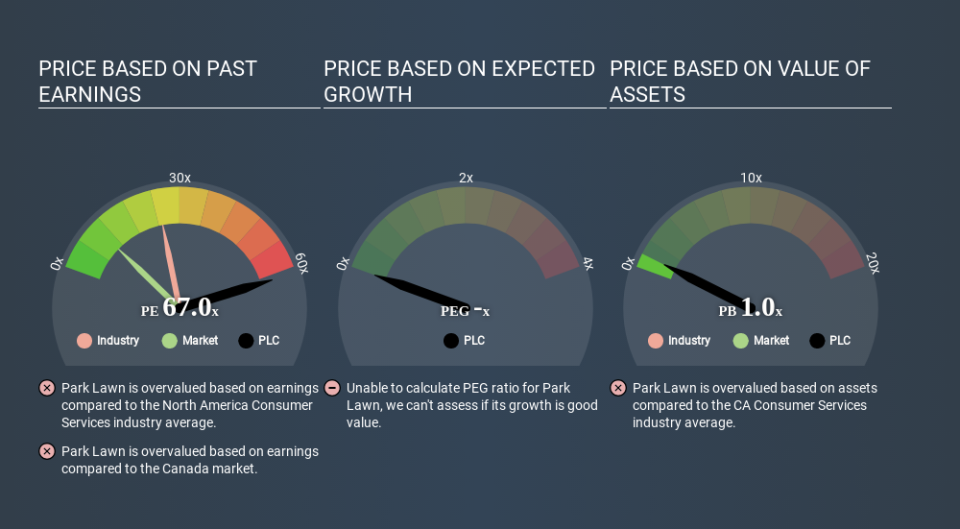A Sliding Share Price Has Us Looking At Park Lawn Corporation's (TSE:PLC) P/E Ratio

Unfortunately for some shareholders, the Park Lawn (TSE:PLC) share price has dived 38% in the last thirty days. That drop has capped off a tough year for shareholders, with the share price down 35% in that time.
Assuming nothing else has changed, a lower share price makes a stock more attractive to potential buyers. In the long term, share prices tend to follow earnings per share, but in the short term prices bounce around in response to short term factors (which are not always obvious). The implication here is that long term investors have an opportunity when expectations of a company are too low. One way to gauge market expectations of a stock is to look at its Price to Earnings Ratio (PE Ratio). Investors have optimistic expectations of companies with higher P/E ratios, compared to companies with lower P/E ratios.
Check out our latest analysis for Park Lawn
Does Park Lawn Have A Relatively High Or Low P/E For Its Industry?
We can tell from its P/E ratio of 66.99 that there is some investor optimism about Park Lawn. The image below shows that Park Lawn has a higher P/E than the average (25.1) P/E for companies in the consumer services industry.
Park Lawn's P/E tells us that market participants think the company will perform better than its industry peers, going forward. Clearly the market expects growth, but it isn't guaranteed. So further research is always essential. I often monitor director buying and selling.
How Growth Rates Impact P/E Ratios
When earnings fall, the 'E' decreases, over time. Therefore, even if you pay a low multiple of earnings now, that multiple will become higher in the future. Then, a higher P/E might scare off shareholders, pushing the share price down.
Park Lawn saw earnings per share decrease by 24% last year. And EPS is down 11% a year, over the last 5 years. This might lead to muted expectations.
A Limitation: P/E Ratios Ignore Debt and Cash In The Bank
It's important to note that the P/E ratio considers the market capitalization, not the enterprise value. That means it doesn't take debt or cash into account. The exact same company would hypothetically deserve a higher P/E ratio if it had a strong balance sheet, than if it had a weak one with lots of debt, because a cashed up company can spend on growth.
Such spending might be good or bad, overall, but the key point here is that you need to look at debt to understand the P/E ratio in context.
How Does Park Lawn's Debt Impact Its P/E Ratio?
Park Lawn's net debt equates to 34% of its market capitalization. While it's worth keeping this in mind, it isn't a worry.
The Bottom Line On Park Lawn's P/E Ratio
With a P/E ratio of 67.0, Park Lawn is expected to grow earnings very strongly in the years to come. With some debt but no EPS growth last year, the market has high expectations of future profits. Given Park Lawn's P/E ratio has declined from 108.4 to 67.0 in the last month, we know for sure that the market is significantly less confident about the business today, than it was back then. For those who prefer to invest with the flow of momentum, that might be a bad sign, but for a contrarian, it may signal opportunity.
When the market is wrong about a stock, it gives savvy investors an opportunity. People often underestimate remarkable growth -- so investors can make money when fast growth is not fully appreciated. So this free report on the analyst consensus forecasts could help you make a master move on this stock.
But note: Park Lawn may not be the best stock to buy. So take a peek at this free list of interesting companies with strong recent earnings growth (and a P/E ratio below 20).
If you spot an error that warrants correction, please contact the editor at editorial-team@simplywallst.com. This article by Simply Wall St is general in nature. It does not constitute a recommendation to buy or sell any stock, and does not take account of your objectives, or your financial situation. Simply Wall St has no position in the stocks mentioned.
We aim to bring you long-term focused research analysis driven by fundamental data. Note that our analysis may not factor in the latest price-sensitive company announcements or qualitative material. Thank you for reading.

